Bioplastic Packaging Market Synopsis:
Bioplastic Packaging Market Size Was Valued at USD 8.50 Billion in 2023, and is Projected to Reach USD 25.98 Billion by 2032, Growing at a CAGR of 14% From 2024-2032.
Bioplastic Packaging market is expanding so rapidly due to awareness of environment and people are eager to get good packaging which is good for the environment. Biodegradable packaging differs from the conventional plastic packaging material in that they are derived from renewable resources such as corn starch, sugarcane and cellulose. Due to pressure from the authorities to completely ban the use of plastics in certain cases and domains and the increasing number of customer environmentally-conscious individuals who are willing to buy goods packed in bioplastic packaging, the majority of food and beverage industries, the body products and pharmaceutical industries use bioplastic packaging. Promoting this change further is not only the development in biopolymer technology that would provide packaging with functional characteristic to allow for versatility but also make the packaging environmentally friendly.
The main driver for the demand of bioplastic packaging is the global concern over the depletion of resources popularly known as plastics particularly those used in single use. Many governments of different countries around different global worlds are implementing measures of avoiding the use of plastics and looking for environmentally sustainable solutions. For instance, the proper policies on usage of biodegradable packaging material are in many countries of Europe. Market is also observing long term corporate programs related to sustainability because corporations have planned their aim related to environment that employs bioplastic packaging for products. This growing intersection in reducing the carbon footprint and Intake of plastics is expected to drive the market growth effectively.
But there are the following disadvantages are raw materials for making the bioplastic are costlier than plastics and at the present; there is no large scale manufacturers of bioplastic. However, daily endeavors and research in the field of bioplastics have led to immense opportunities of improved property as well as acceptance and manufacturing ability of the industry. In addition, the rising awareness among consumers to use products that are friendly to the environment both in packaging and the products themselves, presents the bioplastic packaging market with a good profit chance, since the key manufacturers are already designing sustainable solutions for the packaging market.


Bioplastic Packaging Market Trend Analysis:
Rising Demand for Compostable and Biodegradable Packaging
- The global bioplastic packaging business has been growing strongly over the last decade and some key drivers noted in the report are: Almost everyday consumers and governments lobby for minimization of the use of plastics, industries consider biodegradable packaging materials that disintegrate environmentally friendly. Biodegradable or renewable packaging, usually derived from plant materials like PLA’s or PHA’s are being adopted in the food and beverage distribution channels, since sustainability is now an important corporate goal. Such a trend strengthens the result of the regulatory measures especially in the Europe and North America where governmental ordinances have always been recommending if not mandating the use of biodegradable substitutes for the conventional plastics hence laying the growth of this segment in future.
Technological Advancements in Biopolymer Production
- This has also been complemented by related advancements in biopolymer production technologies globally to the bioplastic packaging market. New ways of processing the fermented products, molecular biology and invention of new feed stocks from bio materials have seen bioplastics developed to possess characteristics such as higher tensile strength, flexibility, heat and moisture resistance. Such advanced bioplastic technology helps in mitigating some of the objections that have generally been associated with bioplastics in terms of cost and flexibility of manufacture. as further researches carried out in this area have indicated, bioplastic packaging is becoming commercially competitive with conventional plastic packaging in terms of functionality and cost, therefore the growing acceptance of this packaging method in various industries.
Bioplastic Packaging Market Segment Analysis:
Bioplastic Packaging Market is Segmented on the basis of By Type, Application, and Region
By Type, Bio-PET segment is expected to dominate the market during the forecast period
- On the basis of type of bioplastic packaging they include the Bio-PET, PLA, PBS, Bio-PP, and others that offer unique properties for packaging. Bio-PET known as polyethylene terephthalate bio-based is frequently used in bottles and containers for strength and because it can be recycled fast are used in the beverages sector. PLA: From resources like cornstarch, PLA is highly utilized for compostable packaging food and personal product packaging and serving items. PBS (polybutylene succinate) It is a material of bio-degradable kind and is utilized in elastic packaging of agri-products and disposals, only. Bio-PP (bio-based polypropylene) is also in demand mainly due to its characteristics: lightweight and might be suitable for use in other industries. These bioplastic types are both on together to extend the market insure eco-friendly solutions to the traditional plastics in packaging.
By Application, Plastic Bottles segment expected to held the largest share
- The bioplastic packaging market can be segmented based on application that include bottles, packaging and others however, the demand for bioplastic packaging is gradually rising in several industries. A particular segment is plastics, specifically, plastic bottles, which were mentioned numerous times as one of the major categories and setting a trend, especially in the beverage and personal care segment where Bio-PET solutions are gaining popularity primarily because they are environmentally friendly and can be recycled. Flexible and rigid packaging for various types of food, cosmetics, and Pharmaceuticals are also extending gradually based on the tendency of biodegradable and compostable demands such as PLA and PBS material. Other uses including agricultural films as well as disposable cutlery under single use are also decomposing the bioplastic packaging business as markets shift towards environmentally friendly packaging.
Bioplastic Packaging Market Regional Insights:
Europe's Bioplastic Packaging market accounts for the second-highest market share.
- Currently, Europe has a second largest market for bioplastic packaging products in the global market, thanks to high environmental legislations consumer awareness, and technology innovation. EU lower-specific regulation on controlling plastic waste including prohibition of single-use plastics and promoting circular economy has pushed the industries to opt for bioplastic packaging. Currently, countries like Germany, France, and Italy are at the pioneering forefront of bioplastic innovation, with various industries, including food and beverage, personal care products, and retail, considering biodegradable and compostable packaging materials . These regulation support blending with rising consumer consciousness towards environ summons the Europe bio-plastic packaging market to pilot a key role on the global platform.
Active Key Players in the Bioplastic Packaging Market
- BASF SE (Germany)
- Dow Chemical Company (United States)
- Koninklijke DSM N.V. (Netherlands)
- Eastman Chemical Company (United States)
- IFS Chemicals (United Kingdom)
- NatureWorks LLC (United States)
- Metabolix Inc. (United States)
- Arkema Group (France)
- Novamont S.P.A (Italy)
- Albis Plastics (Germany)
- Innovia Films (United Kingdom)
- Biome Bioplastics Limited (United Kingdom)
- FKuR Kunststoff (Germany)
- Grace Biotech (Taiwan)
- DaniMer Scientific LLC (United States)
- Other Active Players
|
Bioplastic Packaging Market |
|||
|
Base Year: |
2023 |
Forecast Period: |
2024-2032 |
|
Historical Data: |
2017 to 2023 |
Market Size in 2023: |
USD 8.50 Billion |
|
Forecast Period 2024-32 CAGR: |
14% |
Market Size in 2032: |
USD 25.98 Billion |
|
Segments Covered: |
By Type |
|
|
|
By Application |
|
||
|
By Region |
|
||
|
Key Market Drivers: |
|
||
|
Key Market Restraints: |
|
||
|
Key Opportunities: |
|
||
|
Companies Covered in the report: |
|
||
1.1 Scope and Coverage
Chapter 2:Executive Summary
Chapter 3: Market Landscape
3.1 Market Dynamics
3.1.1 Drivers
3.1.2 Restraints
3.1.3 Opportunities
3.1.4 Challenges
3.2 Market Trend Analysis
3.3 PESTLE Analysis
3.4 Porter's Five Forces Analysis
3.5 Industry Value Chain Analysis
3.6 Ecosystem
3.7 Regulatory Landscape
3.8 Price Trend Analysis
3.9 Patent Analysis
3.10 Technology Evolution
3.11 Investment Pockets
3.12 Import-Export Analysis
Chapter 4: Bioplastic Packaging Market by Type (2018-2032)
4.1 Bioplastic Packaging Market Snapshot and Growth Engine
4.2 Market Overview
4.3 Bio-PET
4.3.1 Introduction and Market Overview
4.3.2 Historic and Forecasted Market Size in Value USD and Volume Units
4.3.3 Key Market Trends, Growth Factors, and Opportunities
4.3.4 Geographic Segmentation Analysis
4.4 PLA
4.5 PBS
4.6 Bio-PP
4.7 Others
Chapter 5: Bioplastic Packaging Market by Application (2018-2032)
5.1 Bioplastic Packaging Market Snapshot and Growth Engine
5.2 Market Overview
5.3 Plastic Bottles
5.3.1 Introduction and Market Overview
5.3.2 Historic and Forecasted Market Size in Value USD and Volume Units
5.3.3 Key Market Trends, Growth Factors, and Opportunities
5.3.4 Geographic Segmentation Analysis
5.4 Packaging
5.5 Others
Chapter 6: Company Profiles and Competitive Analysis
6.1 Competitive Landscape
6.1.1 Competitive Benchmarking
6.1.2 Bioplastic Packaging Market Share by Manufacturer (2024)
6.1.3 Industry BCG Matrix
6.1.4 Heat Map Analysis
6.1.5 Mergers and Acquisitions
6.2 BASF SE (GERMANY)
6.2.1 Company Overview
6.2.2 Key Executives
6.2.3 Company Snapshot
6.2.4 Role of the Company in the Market
6.2.5 Sustainability and Social Responsibility
6.2.6 Operating Business Segments
6.2.7 Product Portfolio
6.2.8 Business Performance
6.2.9 Key Strategic Moves and Recent Developments
6.2.10 SWOT Analysis
6.3 DOW CHEMICAL COMPANY (UNITED STATES)
6.4 KONINKLIJKE DSM N.V. (NETHERLANDS)
6.5 EASTMAN CHEMICAL COMPANY (UNITED STATES)
6.6 IFS CHEMICALS (UNITED KINGDOM)
6.7 NATUREWORKS LLC (UNITED STATES)
6.8 METABOLIX INC. (UNITED STATES)
6.9 ARKEMA GROUP (FRANCE)
6.10 NOVAMONT S.P.A (ITALY)
6.11 ALBIS PLASTICS (GERMANY)
6.12 INNOVIA FILMS (UNITED KINGDOM)
6.13 BIOME BIOPLASTICS LIMITED (UNITED KINGDOM)
6.14 FKUR KUNSTSTOFF (GERMANY)
6.15 GRACE BIOTECH (TAIWAN)
6.16 DANIMER SCIENTIFIC LLC (UNITED STATES)
6.17 OTHER ACTIVE PLAYERS
Chapter 7: Global Bioplastic Packaging Market By Region
7.1 Overview
7.2. North America Bioplastic Packaging Market
7.2.1 Key Market Trends, Growth Factors and Opportunities
7.2.2 Top Key Companies
7.2.3 Historic and Forecasted Market Size by Segments
7.2.4 Historic and Forecasted Market Size by Type
7.2.4.1 Bio-PET
7.2.4.2 PLA
7.2.4.3 PBS
7.2.4.4 Bio-PP
7.2.4.5 Others
7.2.5 Historic and Forecasted Market Size by Application
7.2.5.1 Plastic Bottles
7.2.5.2 Packaging
7.2.5.3 Others
7.2.6 Historic and Forecast Market Size by Country
7.2.6.1 US
7.2.6.2 Canada
7.2.6.3 Mexico
7.3. Eastern Europe Bioplastic Packaging Market
7.3.1 Key Market Trends, Growth Factors and Opportunities
7.3.2 Top Key Companies
7.3.3 Historic and Forecasted Market Size by Segments
7.3.4 Historic and Forecasted Market Size by Type
7.3.4.1 Bio-PET
7.3.4.2 PLA
7.3.4.3 PBS
7.3.4.4 Bio-PP
7.3.4.5 Others
7.3.5 Historic and Forecasted Market Size by Application
7.3.5.1 Plastic Bottles
7.3.5.2 Packaging
7.3.5.3 Others
7.3.6 Historic and Forecast Market Size by Country
7.3.6.1 Russia
7.3.6.2 Bulgaria
7.3.6.3 The Czech Republic
7.3.6.4 Hungary
7.3.6.5 Poland
7.3.6.6 Romania
7.3.6.7 Rest of Eastern Europe
7.4. Western Europe Bioplastic Packaging Market
7.4.1 Key Market Trends, Growth Factors and Opportunities
7.4.2 Top Key Companies
7.4.3 Historic and Forecasted Market Size by Segments
7.4.4 Historic and Forecasted Market Size by Type
7.4.4.1 Bio-PET
7.4.4.2 PLA
7.4.4.3 PBS
7.4.4.4 Bio-PP
7.4.4.5 Others
7.4.5 Historic and Forecasted Market Size by Application
7.4.5.1 Plastic Bottles
7.4.5.2 Packaging
7.4.5.3 Others
7.4.6 Historic and Forecast Market Size by Country
7.4.6.1 Germany
7.4.6.2 UK
7.4.6.3 France
7.4.6.4 The Netherlands
7.4.6.5 Italy
7.4.6.6 Spain
7.4.6.7 Rest of Western Europe
7.5. Asia Pacific Bioplastic Packaging Market
7.5.1 Key Market Trends, Growth Factors and Opportunities
7.5.2 Top Key Companies
7.5.3 Historic and Forecasted Market Size by Segments
7.5.4 Historic and Forecasted Market Size by Type
7.5.4.1 Bio-PET
7.5.4.2 PLA
7.5.4.3 PBS
7.5.4.4 Bio-PP
7.5.4.5 Others
7.5.5 Historic and Forecasted Market Size by Application
7.5.5.1 Plastic Bottles
7.5.5.2 Packaging
7.5.5.3 Others
7.5.6 Historic and Forecast Market Size by Country
7.5.6.1 China
7.5.6.2 India
7.5.6.3 Japan
7.5.6.4 South Korea
7.5.6.5 Malaysia
7.5.6.6 Thailand
7.5.6.7 Vietnam
7.5.6.8 The Philippines
7.5.6.9 Australia
7.5.6.10 New Zealand
7.5.6.11 Rest of APAC
7.6. Middle East & Africa Bioplastic Packaging Market
7.6.1 Key Market Trends, Growth Factors and Opportunities
7.6.2 Top Key Companies
7.6.3 Historic and Forecasted Market Size by Segments
7.6.4 Historic and Forecasted Market Size by Type
7.6.4.1 Bio-PET
7.6.4.2 PLA
7.6.4.3 PBS
7.6.4.4 Bio-PP
7.6.4.5 Others
7.6.5 Historic and Forecasted Market Size by Application
7.6.5.1 Plastic Bottles
7.6.5.2 Packaging
7.6.5.3 Others
7.6.6 Historic and Forecast Market Size by Country
7.6.6.1 Turkiye
7.6.6.2 Bahrain
7.6.6.3 Kuwait
7.6.6.4 Saudi Arabia
7.6.6.5 Qatar
7.6.6.6 UAE
7.6.6.7 Israel
7.6.6.8 South Africa
7.7. South America Bioplastic Packaging Market
7.7.1 Key Market Trends, Growth Factors and Opportunities
7.7.2 Top Key Companies
7.7.3 Historic and Forecasted Market Size by Segments
7.7.4 Historic and Forecasted Market Size by Type
7.7.4.1 Bio-PET
7.7.4.2 PLA
7.7.4.3 PBS
7.7.4.4 Bio-PP
7.7.4.5 Others
7.7.5 Historic and Forecasted Market Size by Application
7.7.5.1 Plastic Bottles
7.7.5.2 Packaging
7.7.5.3 Others
7.7.6 Historic and Forecast Market Size by Country
7.7.6.1 Brazil
7.7.6.2 Argentina
7.7.6.3 Rest of SA
Chapter 8 Analyst Viewpoint and Conclusion
8.1 Recommendations and Concluding Analysis
8.2 Potential Market Strategies
Chapter 9 Research Methodology
9.1 Research Process
9.2 Primary Research
9.3 Secondary Research
|
Bioplastic Packaging Market |
|||
|
Base Year: |
2023 |
Forecast Period: |
2024-2032 |
|
Historical Data: |
2017 to 2023 |
Market Size in 2023: |
USD 8.50 Billion |
|
Forecast Period 2024-32 CAGR: |
14% |
Market Size in 2032: |
USD 25.98 Billion |
|
Segments Covered: |
By Type |
|
|
|
By Application |
|
||
|
By Region |
|
||
|
Key Market Drivers: |
|
||
|
Key Market Restraints: |
|
||
|
Key Opportunities: |
|
||
|
Companies Covered in the report: |
|
||
Frequently Asked Questions :
The forecast period in the Bioplastic Packaging Market research report is 2024-2032.
BASF SE (Germany), Dow Chemical Company (United States), Koninklijke DSM N.V. (Netherlands), Eastman Chemical Company (United States), IFS Chemicals (United Kingdom), NatureWorks LLC (United States), Metabolix Inc. (United States), Arkema Group (France), Novamont S.P.A (Italy), Albis Plastics (Germany), Innovia Films (United Kingdom), Biome Bioplastics Limited (United Kingdom), FKuR Kunststoff (Germany), Grace Biotech (Taiwan), DaniMer Scientific LLC (United States), and Other Active Players.
The Bioplastic Packaging Market is segmented into By Type, By Application and region. By Type (Bio-PET, PLA, PBS, Bio-PP, and Others), By Application (Plastic Bottles, Packaging, and Others). By region, it is analyzed across North America (U.S., Canada, Mexico),Eastern Europe (Russia, Bulgaria, The Czech Republic, Hungary, Poland, Romania, Rest of Eastern Europe), Western Europe (Germany, UK, France, The Netherlands, Italy, Spain, Rest of Western Europe), Asia Pacific (China, India, Japan, South Korea, Malaysia, Thailand, Vietnam, The Philippines, Australia, New-Zealand, Rest of APAC), Middle East & Africa (Turkiye, Bahrain, Kuwait, Saudi Arabia, Qatar, UAE, Israel, South Africa), South America (Brazil, Argentina, Rest of SA).
Bioplastic packaging refers to packaging materials made from renewable biological sources, such as corn starch, sugarcane, or cellulose, rather than traditional fossil fuels. Unlike conventional plastics, bioplastic packaging can be biodegradable or compostable, offering a more environmentally friendly alternative that helps reduce plastic waste and dependence on non-renewable resources. These materials maintain the essential functions of packaging, such as protecting and preserving products, while contributing to sustainability efforts across industries like food and beverages, personal care, and pharmaceuticals. As demand for eco-friendly solutions rises, bioplastic packaging is becoming an increasingly important component in the global push toward sustainable practices.
Bioplastic Packaging Market Size Was Valued at USD 8.50 Billion in 2023, and is Projected to Reach USD 25.98 Billion by 2032, Growing at a CAGR of 14% From 2024-2032.













